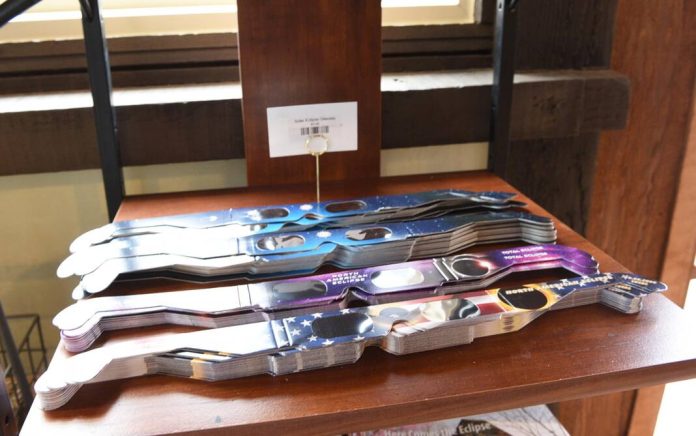“Your vision is not worth the risk of using a damaged filter,” Indiana University School of Optometry clinical assistant professor Dr. Hin Cheung said.
The total solar eclipse will be on April 8 and eye protection is the most important thing to remember. Cheung explained how to protect your eyes and what to look for when picking eclipse glasses.
“The best way to protect your eyes during a partial eclipse, is to either view the eclipse indirectly using a pinhole projector, or to view it directly with an eclipse viewer,” Cheung explained.
“When the sun is completely covered by the moon during totality, it is safe to remove eye protection and enjoy the view.”
A pinhole projector is one of the oldest and simplest optical devices. They are created when light from the sun enters the pinhole and is projected out of the other side of the hole. When the projected light reaches another surface you can see what was passed through the pinhole.
A very simple way to make one is by using two sheets of paper and cutting a hole in one of them to project light on the second. You can also create one using your hands and the ground.
The total solar eclipse will only last around four minutes depending on where you are in the county. The center of Nashville will see the totality for exactly four minutes. When the sun is only partially covered, it is as dangerous to view it with your eyes as it is to stare at the sun normally.
“Direct viewing means you’d look directly at the sun, and the only safe way to do this is through an eclipse viewer,” Cheung said. “This applies not only during an eclipse; it is NEVER safe to look directly at the sun without proper filters. However, once the sun is completely covered by the moon, people can set aside their eclipse glasses and enjoy the view.”
During the partial phase, indirect viewing can be accomplished by looking at a projection of the sun or a shadow of the eclipse.
“As the eclipse occurs, you’ll see the projected image of the sun going from round to a crescent shape.” Cheung said.
The partial phase is similar to what we saw during the partial eclipse in 2017. You might still have your 2017 eclipse glasses in a desk drawer or that box in the back of your closet you always say you’re going to organize — this might be the perfect time for some spring cleaning. If your eclipse glasses meet the requirements for ISO 12312-2, they might still be good and never expire. Information on the ISO 12312.2 requirements can be found at eclipse.aas.org.
“Solar eclipse glasses / viewers newly made for the 2017 partial eclipse should be under the ISO 12312-2 standards,” Cheung said. “This is sometimes printed as ISO 12312-2:2015, that is because these standards were adopted in 2015. This is a worldwide standard which supersedes any previous regional or national standards.If the solar viewer does not have the ISO 12312-2 designation printed on it, then I would not reuse it. If it is a modern ISO 12312-2 solar viewer, then it will last indefinitely, as long as it is stored safely and not damaged. Anyone who kept their 2017 solar viewer — first they need to check to make sure it has the ISO 12312-2 labeling. Then, second, they need to check for any dents, tears, scratches or signs of damage to the viewer before using them.”
Cheung said that glasses with damage could potentially be compromised and should not be trusted. Whether you choose to salvage your 2017 glasses or get new ones, there is a very easy way to test the solar filters at home.
“The only thing you should be able to see through a legit solar filter is something similarly as bright, like the LED flashlight on your smartphone, a bare incandescent lightbulb, or a reflection of the sun off of shiny metal.” Cheung said. Cheung said that you can also use welding filters with a shade number of 12 or higher. The American Astronomical Society recommends welding filters with shade numbers 13 or 14. Looking at the sun during the partial eclipse can cause excess UV radiation leading to eye damage.
“To the front of the eye, this could cause photokeratitis, which is akin to a sunburn on the cornea,” Cheung said. “This heals fairly quickly and is simple to treat, but it can be very uncomfortable and cause blurry vision until it is healed. To the back of the eye, this could cause solar retinopathy, which is damage to the retina. The longer you look at the sun, the more damage will occur. Photochemical damage is cumulative. Staring at the sun for short periods at a time does not protect you; the damage from each viewing adds up. This may cause temporary or even permanent changes to your central vision, which most of us rely heavily on for everyday tasks from driving to watching TV, playing catch to threading a needle. The changes may be blurry vision, distortions to your vision, changes to your color vision perception or a blind spot to your central vision. The potential lifelong consequences can decrease your quality of life and can be easily avoided by viewing the eclipse indirectly or directly with proper eclipse viewers.”
You can find eclipse glasses for free at the Brown County Welcome Center after March 30 with a limit of two per person or the Brown County Library. Glasses are also being sold in various shops around Nashville as well as online. The American Astronomical Society has a reputable list on their website with trusted vendors at eclipse.aas.org.





